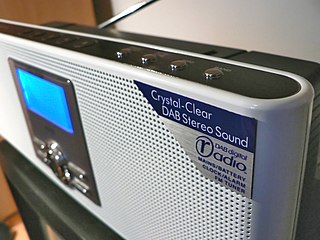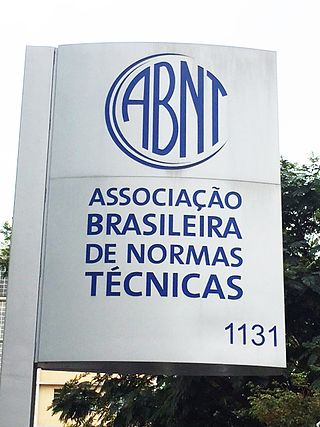
Digital Video Broadcasting (DVB) is a set of international open standards for digital television. DVB standards are maintained by the DVB Project, an international industry consortium, and are published by a Joint Technical Committee (JTC) of the European Telecommunications Standards Institute (ETSI), European Committee for Electrotechnical Standardization (CENELEC) and European Broadcasting Union (EBU).
Integrated Services Digital Broadcasting is a Japanese broadcasting standard for digital television (DTV) and digital radio.

Digital radio is the use of digital technology to transmit or receive across the radio spectrum. Digital transmission by radio waves includes digital broadcasting, and especially digital audio radio services.
ISDB-T International, also known in Brazil as Sistema Brasileiro de Televisão Digital, is a technical standard for digital television broadcast used in Brazil, Argentina, Peru, Botswana, Chile, Honduras, Venezuela, Ecuador, Costa Rica, Paraguay, Philippines, Bolivia, Nicaragua, El Salvador and Uruguay, based on the Japanese ISDB-T standard. ISDB-T International launched into commercial operation on 2 December 2007, in São Paulo, Brazil.
DVB-T2 is an abbreviation for "Digital Video Broadcasting – Second Generation Terrestrial"; it is the extension of the television standard DVB-T, issued by the consortium DVB, devised for the broadcast transmission of digital terrestrial television. DVB has been standardized by ETSI.

The DTG is the association for British digital television broadcasters and annually publish and maintain the technical specifications for digital terrestrial television (DTT) in the United Kingdom, which is known as the D-Book and is used by Freeview, Freeview HD, FreeSat and YouView. The association consists of over 120 UK and international members who can participate in DTG activities to varying degrees, depending on their category of membership.

The Brazilian Technical Standards Association, usually rendered in Portuguese as Associação Brasileira de Normas Técnicas (ABNT) is a private non-profit organization and the normative body which is responsible for technical standards in Brazil, and intends to promote technological development in the country. Brazilian national standards published by the association are named Norma Brasileira and abbreviated NBR.

Ginga is the middleware specification for the Nipo-Brazilian Digital Television System. Ginga is also ITU-T Recommendation for IPTV Services. It is also considered in ITU-T recommendations for Cable Broadcast services and for Terrestrial Broadcast services by ITU-R BT.1889, ITU-R BT.1699 and ITU-R BT.1722. Ginga was developed based on a set of standardized technologies but mainly on innovations developed by Brazilian researchers. Its current reference implementation was released under the GPL license.

ABNT NBR 15601 is the technical standard published by ABNT, the Brazilian Association of Technical Standards, that is responsible for addressing the aspects regarding transmission on the Brazilian Digital Terrestrial Television Standards, also known as SBTVD or ISDB-T version B.

The SBTVD Forum is a non-profit organization of private and public companies responsible for the general aspects of Digital TV deployment in Brazil. The organization was founded in 2007 in order to address all technical issues regarding the upcoming SBTVD standard, also known as ISDB-Tb.

The audio and video compression aspects of the Brazilian Digital Terrestrial Television Standards are described in the three documents published by ABNT, the Brazilian Association of Technical Standards, the ABNT NBR 15602-1:2007 - Digital terrestrial television - Video coding, audio coding and multiplexing - Part 1: Video coding; ABNT NBR 15602-2:2007 - Digital terrestrial television - Video coding, audio coding and multiplexing - Part 2: Audio coding; and ABNT NBR 15602-3:2007 - Digital terrestrial television - Video coding, audio coding and multiplexing - Part 3: Multiplexing signals.

The ABNT NBR 15603 is the technical document of the SBTVD standards that describes in detail aspects regarding Multiplexing and service information (SI). The document is divided in 3 separate parts that covers: SI for digital broadcasting systems ; Data structure and definition of SI basic Information ; and Syntax and definition of SI extended information.

The ABNT NBR 15604 is the document that describes in detail the mandatory and optional functions and features of receivers for the SBTVD. It's essential for the correct implementation by manufacturers of either fixed, mobile or portable receivers aimed at the Brazilian Digital TV market.

The ABNT NBR 15605 is the technical document of the SBTVD standards that describes in detail aspects regarding content security issues and copy protection, also known as digital rights management (DRM). It's a detailed reference for manufacturers and content providers that aim to coordinate transmission and reception protection systems in a transparent and effective way for mass viewing.

ABNT NBR 15606 refers to a collection of technical standards that govern the transmission of digital terrestrial television in Brazil.

The standard ABNT NBR 15607-1:2008 - Digital terrestrial television – Interactivity channel establishes the ways in which a receiver device can send information back to the broadcaster through different communication mechanisms. The transmission of common broadcasting content will be done through the air through the main programming feed, while a more customized use of content can be sent through the interactive channel.
The Brazilian Organization for the Development of Aeronautical Certification is a nonprofit organization, of public interest, regulated by Brazilian Law number 9.790 as of March 23, 1999, and registered at the Brazilian Ministry of Justice on November 28, 2006.

BraSCII is an encoded repertoire of characters that was used in Brazil. It was used in the 1980s on several printers, in applications like Carta Certa, in video boards and it was the standard character set in the Brazilian line of MSX computers. This code page is known by Star printers as Code page 3847.

The Cruzeiro sign ⟨₢⟩ is a typographical abbreviation or ligature consisting of a capital Latin letter ⟨C⟩ with a nested lower-case letter ⟨r⟩, connected in a single glyph.








